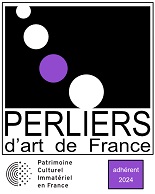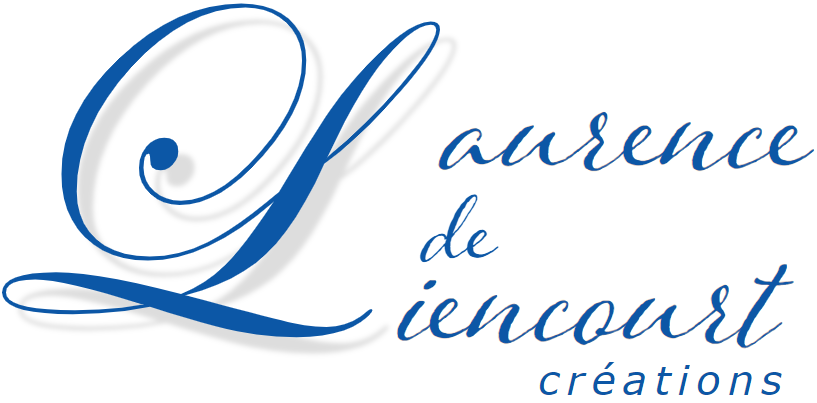Beads and materials used for my jewelry
For the realization of my creations I try to use only noble materials. What do I mean by noble materials?
You will not find here creations elaborated with noble metals such as gold, silver… or precious stones. You will also not find elements made of plastic, metal, resin and other environmentally unfriendly materials. I mainly use beads in glass, mother-of-pearl, seed, wood, shell, ceramic, bone… which I have accumulated over more than 30 years. Sometimes I recycle old buttons, for example plastic, because they have a history or are now considered collector's items.
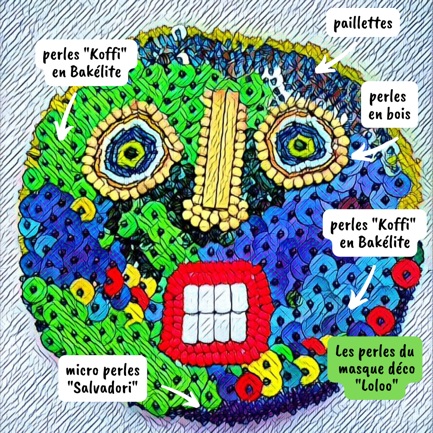
All my pearls have character, sometimes made in the last century. They have sometimes traveled (African pearls).
I try as much as possible to use beads that have a history, beads made using processes that no longer exist today or that are still made but using ancestral methods.
I love imperfect, raw pearls that have crossed oceans and years.
My clasps: allergic to nickel, I banned metal clasps. In the past I used silver clasps but it remains difficult to find original and solid clasps, which age well and which are not made on the other side of the planet. In addition, the crimp beads to attach the wires to the clasp are not always of good quality and I personally find that the result is not always very aesthetic.
That's why I adopted the button. It's kind of my signature...
The buttons I use are sometimes on their own, real works of art.
Here are some examples of beads or materials used:
Glass Barter Beads "Padre Beads"
Originally made in Europe, these beads traveled around the world to Africa and the Americas by Spanish missionaries, monks and traders and were used as currency. The name of these beads comes from the 16th to 18th century Spanish Catholic priests called "Padre" or "Father".
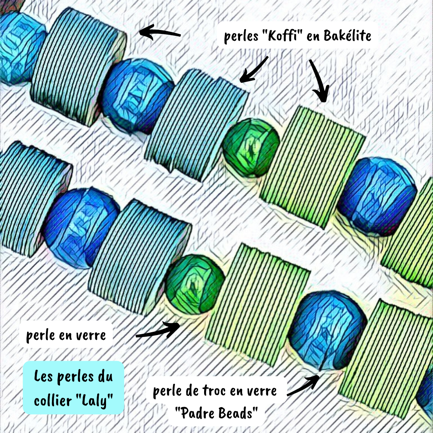
The pearls of the “Laly” necklace
Ancient Venetian Beads:
Opalescent Venetian glass which dates from the 1920s originally for the manufacture of Venetian glass beads and the decoration of chandeliers.
These beads were cut by hand, so they are very irregular, all different and unique.

The pearls of the “Louti” necklace
Porcelain
Porcelain is not made from natural clay. It is mainly composed of a mixture of quartz, feldspar and kaolin, with the addition of pipe clay to increase its plasticity. Quartz and feldspar are reduced to powder by the action of granite millstones, then ground in a rotating cylinder containing pebbles and water. Feldspar lowers the vitrification point of porcelain during firing.
Its origin comes from China. History says that it was in the 13th century during his trip to China that Marco Polo brought back porcelain objects. The production method has long been a mystery. Porcelain fascinates, it is even nicknamed "white gold". Kaolin having been the missing element in all attempts to produce this ceramic derivative. The first Western porcelain factory is created in Meissen.

The pearls of the “Lihi” necklace
Corozo
Corozo is a natural material made from the seeds of the corozo palm. Also known as vegetable ivory, corozo is an ecologically responsible vegetable material. Unlike plastic, it is non-toxic and biodegradable. The production of Corozo buttons does not require the felling of trees, as the buttons are made from the tree nuts. Corozo seeds can only be harvested when they fall naturally from the tree - otherwise they are not ripe enough to produce buds. The production of corozo buttons therefore does not require any deforestation.
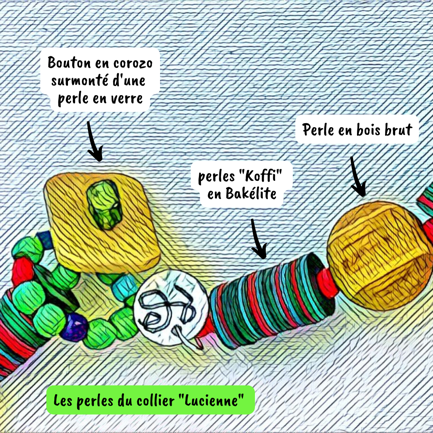
The pearls of the “Lucienne” necklace
mother-of-pearl
Mother-of-pearl is the material par excellence for making buttons.
Mother-of-pearl comes from the cutting and polishing of mother-of-pearl shell (an “oyster” type mollusk). Therefore of natural origin, mother-of-pearl buttons are characterized by their density and shine. Their mollusc origin also gives them subtle reflections which are difficult to imitate in plastic buttons. These reflections can have some shades of blue/petroleum green, so characteristic of the interior of shellfish such as oysters. The natural color of mother-of-pearl is originally cream/white.
Koffi pearls
The koffi washers are made of bakelite, an ancestor material of the plastic with which our black telephones were made. This type of pearl is becoming rare because it is no longer made today.
Bakelite is the first plastic material discovered in 1909 by Leo Baekeland, a naturalized American Belgian chemist, known for his research in photography and plastics.
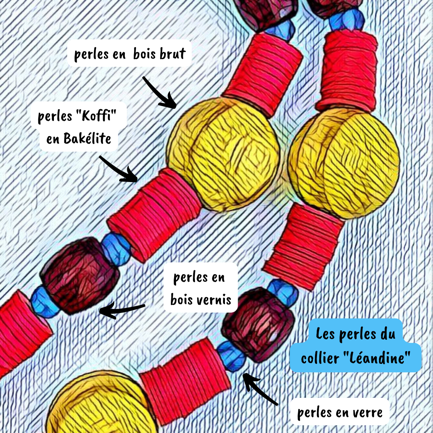
The pearls of the “Léandine” necklace
Trade Beads
Manufactured in Egypt and Europe (Venice, Bohemia, Germany, France), glass beads were “verroterie”, a sort of barter currency. These pearls, mixed with other junk goods, were used in Africa to acquire gold, ivory and slaves and on the American coasts, to negotiate all the tropical products that Europe loved: sugar, cotton, skins, cocoa, spices, precious metals…
“Barter beads, for the most part, served as “CURRENCY” for BARTER in Africa during the following 3 major historical periods:
1- The Muslim trans-Saharan slave trade (between the 7th and 15th centuries)
Beads from the "Islamic period" made in Egypt and the Middle East
2- The European transatlantic slave trade (from the 16th century to the end of the 18th century, beginning of the 19th century)
The pearls were made at:
-
- Venice – Murano (Italy)
- Bohemia (province of the present Czech Republic)
- Briare (in the Loiret – France)
American collectors call these beads "African trade beads".
3- European colonization (from 1850 to 1960)
African pearls (Mauritania, Mali, Ghana, Ethiopia, Madagascar, ...)
(MIFAP Traveling Museum of the Ancient Pearl in France)
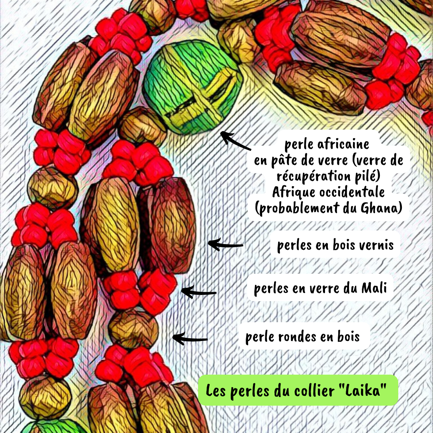
The pearls of the “Laika” necklace
Loubia pearls
These red pearls, often called Ethiopian pearls everywhere in Africa, are Bohemian pearls where they were made in the late 18th and early 19th century, then exported to various African countries including Ethiopia where many of these pearls are found.

The pearls of the “Laura” necklace
Brazil Acai Seed Beads
Seed of a fruit widely consumed in South America that grows in clusters on the Acai palm, from the Portuguese "Açaizeiro".
The etymology of the word acai is in the Tupi vocabulary of the South American Indians "iwasa'i" which means "the fruit that cries" in other words, the fruit that expels water.
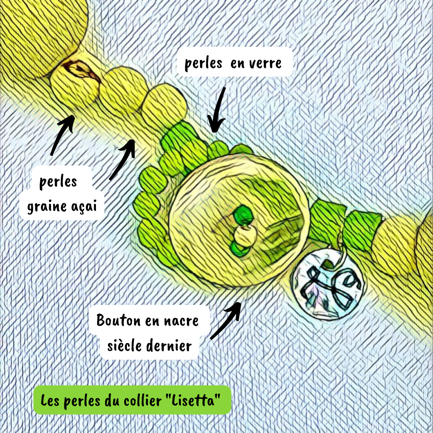
The pearls of the “Lisetta” necklace
Raffia
The term 'Raffia' defines both the palm tree and the fiber extracted from it, the word is of Malagasy origin. Raffia is a vegetable fiber used in many ways. As surprising as it may seem, it comes from a palm native to Madagascar named Raphia Farinifera, part of the Arecaceae family.
The long palm leaves are dried and then cut into thin strips which will then be rolled up to form the raffia that we know in coils.
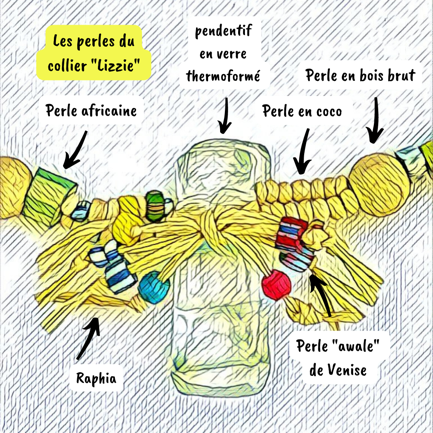
The pearls of the “Lizzie” necklace
Sequins
From design to cutting through color, Langlois-Martin sequins are 100% French-made.
They are made of Cellulose Acetate: The cellulose acetate used is a plant material composed of cotton or wood fibers. The cellulose acetate used to make the flakes is produced from wood from eco-managed European forests and recycled acetate (up to 25% or more).
Rock crystal
Rock crystal is a mineral belonging to the quartz family and silicate group. It is a very resistant and completely transparent fine stone. It is a so-called semi-precious stone. In the field of jewelry, this gem is widely used, especially in the brilliant, cabochon or even pearl form. Quartz is also used in the fields of metallurgy, construction, glassware and electronics.
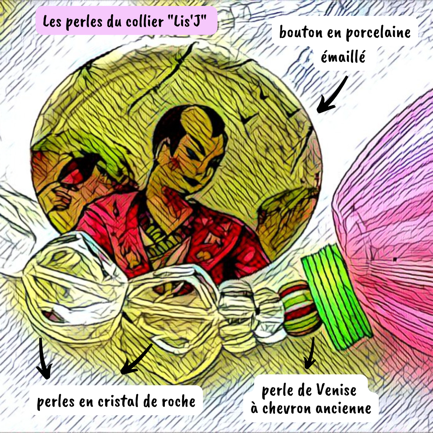
The pearls of the "Lis' J" necklace
Hematite
Hematite is a mineral species composed of iron oxide. The metallic luster of hematite is almost unique and if you add its great density and weight you won't find a gem like it. Its name comes from the Greek word "hema" which means "blood", because hematite in powder or in very thin slices is blood red. Moreover, the powder of this gem has been used as a red pigment for many years.
It is a soft stone and it scratches easily and therefore should be kept away from other jewellery.
Jet
Jet is a fossil gem formed by the action of ocean pressure on a sedimentary rock composed of the fossil remains of plants. This variety of combustible fossil lignite, hard, compact in appearance, glassy and shiny black, is capable of being treated like a fine stone, faceted and polished; it is used in particular for making jewellery, mourning adornments, trimmings, and tableware works.
Jet gives off a charcoal smell when burned with a hot needle. It has often been imitated and to distinguish it, it suffices to draw a line with it, which must be brown in color.
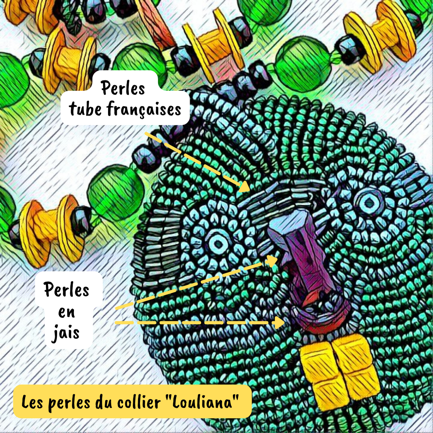
The pearls of the “Louliana” necklace
Washi
Washi is a traditional Japanese paper made from "Kuma-Zasa" (bamboo grass/Sasa Veitchii).
Laurence de Liencourt is member of :
